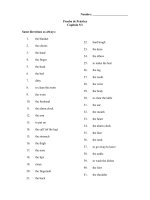ENGLISH 6
Bạn đang xem bản rút gọn của tài liệu. Xem và tải ngay bản đầy đủ của tài liệu tại đây (98.7 KB, 3 trang )
<span class='text_page_counter'>(1)</span><div class='page_container' data-page=1>
<b>UNIT 14: LESSON 5. C1-3</b>
<b>Period 87</b>
<b>A. OBJECTIVES:</b>
By the end of the lesson, students will be able to make suggestion and responding and do
futher practice in “want to do”.
Knowledge:. - "let's", 'What about...?" , "Why don't you...?" and responding : further practice
in "want to (do)"
Skills: Listening – Speaking – Writing – Reading.
Attitude: Show positive attitude to learning, and express friendships.
<b>B. TEACHING AIDS.</b>
- Lesson plan, English book, visual aids, projector, laptop, speaker
<b>C. METHODS: </b>brainstorm, pre-questions, picture drill, mapped -D
<b>D. CONTENTS:</b>
<b>I. Organization:</b>
<b>Class Date of teaching Absent Ss</b>
<b>6A1</b> ... ...
6A2
6A3
<b>Teacher and Ss’ activities</b> <b>Content </b>
<b>II. Warm up: (5 minutes)</b>
Brainstorm
- Ask students to tell the names of the interesting
places in Viet Nam which they’d like to visit during
summer vocation.
- Get them to go to the board and write down their
ideas.
- Give feedback.
Chatting
1. Where do you often go on vacation?
2. How do you often go on vacation?
<b>III. New lesson.</b>
<b>Step 1. Presentation: (14 minutes)</b>
Act 1: Pre-teach vocab:
- Listen to the teacher.
- Repeat after the teacher.
- Write the new words in their notebooks.
Checking understanding:
Rubout and remember
-Point to the Vietnamese translations and rub out
English words.
- Get students to call the English words.
- Students repeat chorally and remember all the
English words.
- Call the English words and write the English words
if there is time.
Activity 2. Pre –questions
Presentation dialogue
Interesting places
in VN
Ha Long
<b>I. New words</b>
- minibus (n) : xe buýt nho
- pagoda(n) : chùa
- suggestion(n) : sự gợi ý
- good idea(n) : ý kiến hay
-too (adv): quá
-far (adv) : xa
too far : quá xa
</div>
<span class='text_page_counter'>(2)</span><div class='page_container' data-page=2>
<i><b>* Set the scene</b></i>
Look at the picture. There are four students. They are:
Lan, Nam, Nga and Ba
-Shows the Qs on the B
<i>-Ss: </i>Guess what answers are
- T. plays the tape C1, ss listen and check
<b>Answer key</b>
1. They are going camping
2, They are going to travel by bus
Comprehension questions
- Ask them to play the roles of Ba and Lan, Nam and
Nga
- Ask students to answer the questions.
- Ask students to isolate the model sentence
<b>Model sentences: Make suggestion</b>
Muốn đưa ra lời đề nghị hoặc gợi ý, ta có thể dùng:
- Let's
- What about...V-ing?
- Why don't we...?
- Where are they going to go?
- How are they going to travel?
<b>Step 2. Practice.(15 minutes)</b>
Act 1. Picture drill. C3. P.148, 149:
Hang the pictures on the board
- T does the model
<i>+Let’s go swimming.</i>
<i>+ Yes, let’s.</i>
- Do the same for the seccond picture.
- Correct their mistakes.
a) go swimming
b) go to the musium
c) play volleyball
d) go to the zoo
e) play badminton
f) go camping
<b>act 2. words drill: Make suggestion</b>
- SS run through the pictures/ words
- Look at the pictures.
- Listen to the teacher.
- Repeat it chorally and then individually.
- Make the sentence for themselves.
<b>Step 3. Further practice.(8 minutes)</b>
* Mapped dialogue:
- Put the dialogue on the board which is only words.
The words are cues.
1. They are going camping
2, They are going to travel by bus
<b>II. Listen and read</b>
a. He wants to go to Hue
b. She wants to go to Huong pagoda
c. She wants to go on foot.
d. Because it is too far
e. He want to go by bike.
f. Because it’s too hot.
g. He wants to go by minibus.
<b> Structues:</b>
<b>- Let’s + V... chúng ta hãy..</b>
<b>- Why don’t we + V(o) + ..? tại sao </b>
chúng ta k..?
<b>- What about + Ving..? cịn...thì sao? </b>
(chúng ta hãy..
(+) Yes, let’s./ OK
That’s a good idea./ Good idea.
(-)No, let’s not.
No, it’s not a good idea.
Use : Make suggestion
<b>III. Practice </b>
a) - Let's go to the beach.
- That's a good idea.
b) - What about going to the
museum?
- No, I don't want to go there.
c) Why don't we play volleyball?
- That's a good idea.
d) Why don’t we go to the zoo ?
- That’s a good idea.
e) Let’s play badminton ?
- That’s a good idea.
f) What about going camping ?
- That’s a good idea.
</div>
<span class='text_page_counter'>(3)</span><div class='page_container' data-page=3>
- Model the dialogue.
- Run through the cues like a drill with the whole
class.
Example exchange:
S1: Let’s see a movie.
S2: No, let’s not. Let’s go to the beach.
S1: No, I don’t want to. It’s too hot. Let’s go to the
museum.
S2: Yes, let’s walk there.
S1: No. Let’s go bus bus.
S2: Yes, that’s a good idea.
<b>IV: Summary.(2 minutes)</b>
- Repeat the content of the lesson.
Make suggestion: Lets’ / what about/ why don’t we?
<b>V. Home work:(1 minute)</b>
Ask Sts to do exercises part C.
+ Review Unit 12 , 13 , 14
*/ Questions for revision
- Future tense : Be going to
Want / woulk like + to – V
Talk about weather and seasons
Adverb of frequency
S1 S2
...see a movie? No, ...go to the
beach
No, ...too hot.
...go to the
museum. Yes...walk.
No. ...go by
bus.
</div>
<!--links-->









